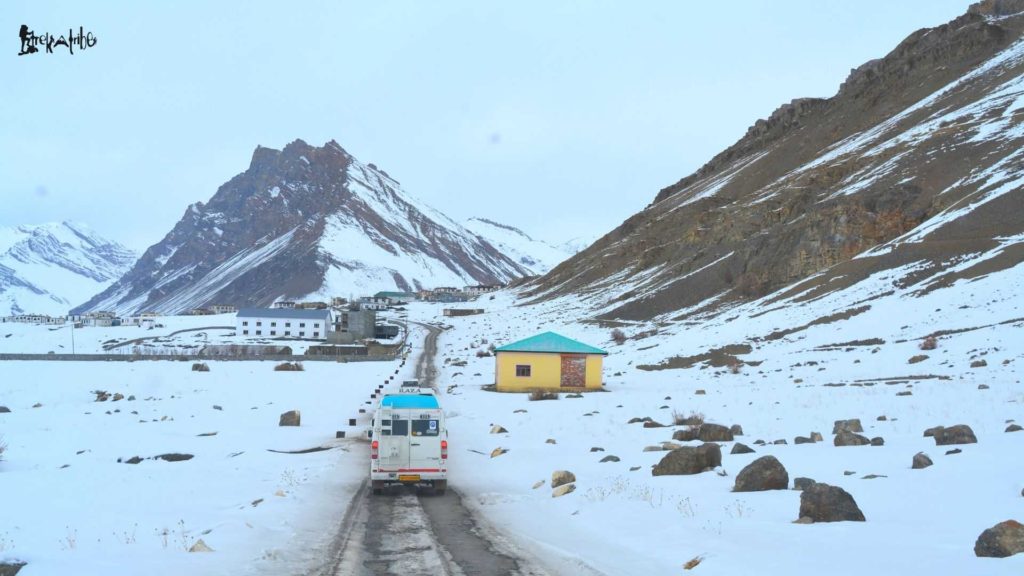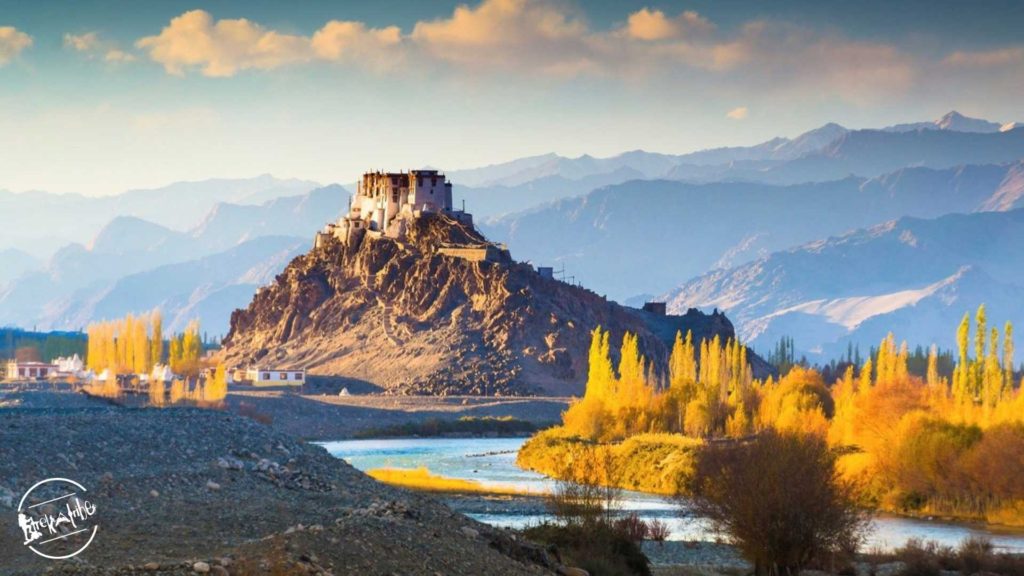- Trip Itinerary
- Inclusions/Guidance
- Trip Excludes
- FAQ
Cold Desert Road Trip
With the summer heat giving way to the maddening monsoons of the hills, with landslides and road blockages in most parts of the Himalayas, this road trip to the cold desert is your perfect getaway to escape the scorching heat and humidity of the cities and the endless rains of the mountains. What if you do all this, and more at one of the highest places in India? Where no vegetation grows, and the valleys are flanked by tall, naked, and barren mountains with snow-capped peaks. Where very few vehicles make it because there are no roads, just rubble, and boulders, where there is raw beauty wherever you look!
Spiti, the ‘middle land’, is one of our favorite destinations. It not only gives us respite from the heat but also teaches us how to truly live and let go! But Spiti is not for those who seek a luxurious getaway, or for the fainthearted. If you’re someone looking to explore the local Spitian culture by staying in rustic homestays and eating local food, come on board as we journey through this magical land exploring hidden gems and making countless memories under the stars.
Highlights of the Trip:
-Visit age-old temples.
-Explore monasteries hanging from cliffs.
-Experience the Upper Himalayas.
-Uncover the mystery of a 500-year-old mummy.
-Sit by Crystal Blue Lakes and relax.
-Send a postcard from the highest post office in the world.
-Explore the beautiful rustic lands of Kinnaur.
-Cross some of the highest passes in the world.
-Stay under a billion-star sky.
We have given wings to your desires to unleash the true beauty of the Himalayas in such rustic landscapes. If you are challenging enough to explore the enthralling experience of the Kinnaur-Spiti road trip, book with us today!
Fixed Departure Dates:
10-18 May | 17-25 May | 24 May- 1 June | 31 May- 8 June | 7 – 15 June | 14 – 22 June | 21 -29 June | 5-13 July | 12-20 July
*You may also plan a custom trip to Spiti Valley on any dates you prefer with different pricing plans.
We provide sanitized Transportation, follow COVID norms, and provide a hygienic Stay.
Itineraries
Day 1
DELHI - SHIMLA (OVERNIGHT TRAVEL)
-Board an overnight Volvo bus from Delhi to Shimla.
-Delhi Pick-up Point: ISBT Kashmiri Gate/ Majnu ka Tilla
-Pick-up Time: 10-11 pm (average time)
Day 2
Time : 7:00 am
SHIMLA- NARKANDA- CHITKUL
This epic Road Trip will start from ISBT Shimla in a comfortable Tempo Traveller. We rise and shine early in the morning and get a head start on our road trip to cover 250 kilometers towards Chitkul in 9 hours. This small village in the Kinnaur district is the home to some of the finest potatoes of the world. Popularly known as the last inhabited village near the Indo- Tibetan Border, the Indian roads end here at Chitkul. The village is famous for its traditional pahadi houses with roofs made of either slate or wooden planks. Adorned with high snowclad mountain peaks, Chitkul is also often known as the Swiss Alps of India!
After feasting on some lunch and dinner en route, we spend the night tucked in in a comfortable hotel, ready for the day ahead.
Day 3
CHITKUL- KALPA
We start our morning going around Chitkul and experiencing a blissful morning in the Kinnauri region of Himachal. After exploring Chitkul we drive towards Kalpa in the Kinnaur District itself. Kalpa is a beautiful village, known best for its apples and chilgoza or the Pinus gerardiana. Located at the base of the Kinnaur Kailash Range, Kalpa is blessed with spectacular views of the higher mountains, especially during sunrise and sunset with the light rays of the sun touching the snowclad peaks. The Shivling Peak standing 6,000 meters tall also looms over the village of Kalpa! After exploring through this naturally beautiful village and the famous suicide point, we retire for the night in our comfortable hotel rooms.
Day 4
KALPA- NAKO- GIU-TABO
We start our morning by a visit to the suicide point and experiencing a blissful morning in the Kinnauri region of Himachal. From here, we depart for Tabo while crossing the treacherous Malling stream. En route to Tabo we will visit Nako, the most picturesque hamlet of Kinnaur, we visit the Nako Lake. After this, we now enter the vast Spiti Valley, while crossing the check post at Sumdo. We drive further to the village Giu, located 17 kilometers from Sumdo. Giu village is known for its 500 years old mysterious mummy which still has its teeth and hair intact. After visiting the temple where this mummy is still preserved we head to Tabo where The Dalai Lama has expressed his wishes to Tabo Monastery since it is considered one of the holiest. After a full day of moving around, we finally call it a night at a hotel in Tabo.
Day 5
TABO- DHANKAR- PIN VALLEY- KAZA
From Tabo, we then move on to explore Dhankar Monastery. Dhankar used to be the administrative capital of Spiti before Kaza. We explore the village and visit the Dhankar Gompa situated asymmetrically atop a steep cliff. This hill-top fort that overlooks the Spiti Valley also once used to serve as a jail in the olden days. After spending some amazing moments in this peaceful monastery, we head towards Mudh which is a high-altitude village located in Pin Valley of Spiti District. Pin Valley is known for its Pin Valley National Park, home to the snow leopard and Siberian ibex. With such high reaches and glaciers where humankind seldom goes, Pin Valley might as well be the highlight of your trip! Mudh is the last motorable village in India on this side and is also the base camp for a number of long treks including the famous Pin Bhabha Pass Trek. Known for its sprouting pink blossoms known as Sia Mentok, Mudh is an enchanting land that is sure to leave you awestruck! From Mudh, we finally head to our final destination of the day, Kaza, the administrative capital and largest town of Spiti, and hit our comfortable beds after these meanderings.
Day 6
KAZA- HIKKIM- KOMIC- LANGZA-KEY-KAZA
On this day we explore some of the highest inhabited regions of the world. Our first stop will be at Komic, which literally translates to ‘eye of a snow cock’. Komic is the highest motorable village in the world at a height of 4,587 meters! After spending some time taking in the beauty of this enchanting village, we head to Hikkim, home of the highest post office in the world. Next we visit Langza, situated at an altitude of 4,400 meters. Once at Langza we can stroll around and visit the ancient Lang which is a 1000 years old temple and spot the marine fossils found here in the sedimentary rocks. After lunch we will visit Key, known for its magnificent Key Monastery situated at the foot of steep ridges, it is also the Biggest Gelugpa Sect Monastery in Spiti. This monastery is also known to have a training centre for the Lamas. Overlooking the Spiti River, looking down at the valley from any spot of this upland country is a great sight. Spending some time in the peace and quiet of this monastery can really be a soulful experience, something to remember for a lifetime. We return back to Kaza and you are free to explore the market at Kaza and buy souvenirs for your family and friends. We return back to our homestay for dinner and a night's stay.
Day 7
KAZA- KIBBER- CHICHAM- LOSAR- KUNZUM PASS- CHANDRATAL
From Kaza, we drive to Kibber. Kibber is also home to the majestic snow leopard and gives a breath-taking view of Kanamo Peak at 19,600 feet. From Kibber, we visit the famous Chicham Bridge, the highest bridge in Asia, and hear stories about the ancient method of using pulley trolleys. We now drive through the least populated village of Spiti- Losar, to reach India’s highest motorable mountain pass which connects Kullu and Lahaul to Spiti valley- Kunzum La at 15,000 feet. From Kunzum La, we head towards one of the most photogenic places in Spiti Valley- the breath-taking Chandratal Lake, also known as the lake of the moon. This magnificent lake has surprisingly no visible source of water, concluding that the water for this lake comes from underground. We spend the night in camps and spend our evening gazing at millions of stars on a clear night.
Day 8
Time : 7:00 pm
CHANDRATAL- CHHATRU- ATAL TUNNEL- MANALI
To celebrate our last day in Spiti Valley, we depart from Chandratal Lake and make our way to Batal, home to the famous Chachi Chachi ka Chandra Dhaba. From there we continue our journey on Kaza – Manali Highway while taking a lunch halt at Chhatru. Driving beside the Chandra river we pass Gramphoo village and enter Atal Tunnel (Rohtang Tunnel) to reach Manali, thus entering the Kullu District. The tunnel is intended to create an all-weather route to Leh and Lahaul and Spiti valleys in Himachal Pradesh. The 9.02 km-long tunnel passes under the Rohtang Pass in the eastern Pir Panjal range on the Leh-Manali highway.
We reach Manali, only to head back home with a heart full of happy memories.
Day 9
DELHI ARRIVAL
-Arrive in Delhi early in the morning (6-10 am).
-The trip ends with good memories.
Buffer Day
BUFFER DAY
It is important to have an extra day as any bad weather condition or landslides may delay your journey. In case another day is utilized, you need to pay ₹ 2500 for buffer day expenses.
Inclusions
- Accommodation in Hotel/Homestay/Camping (6 nights)
- Transportation: Delhi to Shimla/Manali to Delhi by overnight Volvo bus; Shimla to Manali in Tempo Traveller/Innova
- MAP meal plan (6 Breakfast and 6 Dinner)
- Experienced and Local Driver cum Guide
- Tour Captain
- First-Aid Kit
- GST
*This Trip can be arranged from Delhi to Delhi at a total cost of ₹ 19,500 p.p (inclusive of Volvo bus Travel) (Early-Bird)
₹ 18,000 p.p Shimla-Manali cost
You need to pay 50% of the cost of the trip to book your seat with us.
Direct Account Transfer:
Trekatribe Tour & Travels
Account Number:37715220647
IFSC Code:SBIN0002490
State Bank of India
Paytm Transfer Number: 9805440456
Google Pay Transfer Number: 9805440456
UPI ID: trekatribe@oksbi
What should I wear/carry in Spiti Valley?
– Down Jacket
– 2x Trek Pants/Jeans
– A fleece jacket or windcheater jacket or windproof jacket to prevent the winds (must-have)
– A good sturdy pair of shoes
– A 50-65 L backpack (Do not carry suitcases or trolley bags please)
– Woollen socks
– Heavy woollens 2-3 sets (Sweatshirts/Fleece/pullovers/warm hoodie)
– Carry a cap and Sunscreen Lotion to protect yourself from direct sunlight as it is too harsh in this region to protect yourself from UV rays
– Sunglasses to protect your eyes from the hard sun
– Hand gloves are a must-have in October to June.
– Wollen Cap (must-have)
– Lip balm
– Carry your water bottle and refill it
– Powerbank
– Camera Bag if you use DSLR/GoPro
– Any personal medicine for allergies/Medical conditions
– Spare contact lenses or glasses
– Towel especially lightweight quick-dry type
– Reading materials, Games, Cards. (Optional)
– Bsnl/Jio Simcard
– Identification proof like Passport, Driving license, Aadhar card etc.
Other Guidance
- Travellers are reminded that there is a 15 kg limit on personal luggage for all trips.
- Cameras, whether video or film, needed to be protected against the severe cold either in a warm pouch or the interior pockets of your clothing. Do not keep your camera in your backpack at higher elevations.
- No insurance is provided during the trip of any kind.
- When you travel, please never litter.
- Remember – “Take nothing but photographs, leave nothing but footprints”. So, keep the mountains clean and green.
- Aspirins and Paracetamols are highly recommended for headaches and because they also thin the blood which will help improve circulation & oxygen delivery to the body. Strong painkillers are not recommended as they can suppress respiration.
- Personal expenses of any kind will not be entertained.
REFUND & CANCELLATION POLICY
- Cancellation of booking of tour 31 days or more before the date of Departure will result in a 20% deduction from the total cost of the tour.
- Cancellation of booking of tour 21-30 days before the date of Departure will result in a 40% deduction from the total cost of the tour.
- Cancellation of booking of tour 11-20 days before the date of Departure will result in a 60% deduction from the total cost of the tour.
- Cancellation of booking of tour 6-10 days before the date of Departure will result in an 80% deduction from the total cost of the tour.
- Cancellation of booking of tour 1-5 days before the date of Departure will result in a 100% deduction from the total cost of the tour.
Exclusions
- Anything not mentioned in the inclusion list
- Meals during Transportation (Lunch)
- Expenses of personal nature
- Expenses raised due to any road blockage or natural calamity
(The itinerary is subject to change and is flexible due to any circumstances which are not in our control)
Summers are the most ideal season to visit Spiti Valley. All routes remain open from May to September and the weather is pleasant. Winters in Spiti Valley is a different experience altogether. If you want to experience snow and sub-zero temperatures, this is the best experience for you. However, some routes close down during winters and Chandratal, Rohtang Pass and Kunzum Pass remain inaccessible due to heavy snow.
The days are warm and sunny during the summers in Spiti, with temperatures ranging around 25 degrees Celsius. However, the nights get cold and chilly with temperatures dropping to 5 degrees even in summers. Winters are cold and harsh, and temperatures remain well below zero throughout the day. The days are usually minus -5 degrees and nights dip down to minus 15 degrees!
Regardless of which season you choose to travel to Spiti, it’s important to carry enough warm clothes. In summers, a simple cotton T-shirt and pants suffice during the day but at night, at least two-three layers of warm clothes would be needed. Layering is very necessary during the winters. Start with a base layer, followed by a fleece jacket, a sweater and finally a heavy winter jacket. Wear a base layer beneath your bottoms as well.
Altitude mountain sickness (AMS) occurs in high altitude regions due to lower levels of oxygen. Since Spiti Valley starts at an altitude of 3,800 meters above sea level, AMS is quite common there. Symptoms include shortness of breath, headache, and dizziness/ nausea. To prevent AMS, it is important to acclimatize well, drink water at regular intervals and eat healthy food. It is advised to not smoke or drink as they can aggravate AMS.
Since smoking and drinking aggravate altitude mountain sickness, we advise our guests to not engage in these activities.
Jio and Bsnl work well in Spiti Valley but it is not reliable as the network comes and goes.
We book hotels and homestays during the trip. At Chandratal, accommodation is arranged in tents. Both twin sharing and triple sharing options are available, at the same cost.
Yes. We make sure all our pit stops on the road are equipped with toilets. Proper toilets at every homestay and hotels available.
Absolutely! Spiti Valley is a very safe place for women. We have hosted several solo female travellers in the past and the sex ratio on our trips is usually 50-50 with other solo female travellers.
Our batches usually include 12 people on an average.
We request you to book at least 50% of the trip cost to confirm your booking with us. There are multiple payment methods available to book with Trekatribe. Once the payment is done, please share a screenshot with us for our records!
Direct Account Transfer:
Trekatribe Tour & Travels
Account Number:37715220647
IFSC Code: SBIN0002490
State Bank of India
Paytm Transfer Number: 9805440456
Google Pay Transfer Number: 9805440456
UPI ID: trekatribe@okicici | trekatribe@oksbi
• Cancellation of booking of tour 31 days or more before the date of Departure will result in a 20% deduction in the cost of the tour.
• Cancellation of booking of tour 21-30 days before the date of Departure will result in a 40% deduction of the cost of the tour.
• Cancellation of booking of tour 11-20 days before the date of Departure will result in 60% deduction of the cost of the tour.
• Cancellation of booking of tour 6-10 days before the date of Departure will result in 80% deduction of the cost of the tour.
• Cancellation of booking of tour 1-5 days before the date of Departure will result in a 100% deduction of the cost of the tour.



